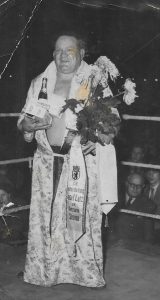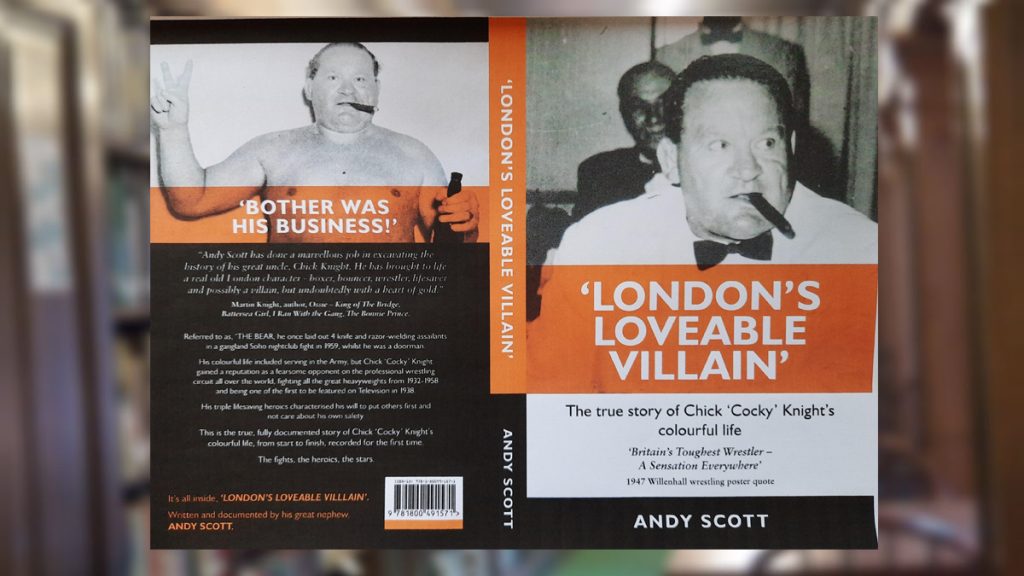Many of us are driven to understand more about our ancestors and learn about the distant family members who helped shape our lives. It is a curiosity about what makes each of us the people that we have become and can link our very being to historic moments and figures. For some, researching family history comes with an important sense of duty – it can preserve the legacy of the departed souls and forgotten names whose lives have ultimately resulted in our own existence.

Chick “Cocky” Knight celebrating winning a tournament in the early 1950s, possibly in Germany. All photos courtesy of Andy Scott.
It is this approach which has led to the creation of a uniquely compelling biography ‘London’s Loveable Villain:’ The True Story of Chick ‘Cocky’ Knight’s Colourful Life, out now from Nielsen Independent Publishing. From a quick glance of the cover, one might be forgiven for assuming that this book is a true crime story of a mob boss, as its rugged subject is dressed to the nines in formal dinner attire while shown to be chomping on a stogie. But no, this is the story of a hard man with a difference, as one of the most prolific British names from the explosion of “all-in” wrestling during its boom in the late thirties.
This book is comprised of two main sections. The first part is a biography of Arthur Richard George Knight, better known as Chick “Cocky” Knight, and has been penned by his great nephew Andy Scott, a journalist who has extensive experience in writing for mainstream media, including the BBC. The second part (which actually encompasses the majority of the text), is a timeline of Knight’s career, with information culled from newspaper extracts, fan results, and other source articles that the author was able to salvage.
In 2021, historical biographies of pro wrestlers from a disparate era and culture are unlikely to draw major commercial interest, but it is unlikely that this was the motive of the author in this audacious, and time-consuming undertaking. Scott capitalizes on his mainstream writing experience to depict a more personal story captured through an accessible (and at times, conversational) prose, while taking the reader on a journey of investigation and discovery.
In some ways, ‘London’s Loveable Villain’ reads as a story of dueling narratives told across the body of the novel. One being the biography of Knight, and the other being a personal journey of Scott to learn about his long-deceased relative, and champion public recognition to his many accomplishments.
From the start of the biography, the author depicts a lurid picture of the London district of Hammersmith at the dawn of the 20th century. The reader is soon introduced to the unionized taxi-driving workforce in which Knight’s father, George, was a member. Knight’s childhood is captured in as much detail as could be expected, using census statistics and family records, however, it is the cursory information about the environment and time frame in which he was raised that help bring this biography to life. With the death of his mother, Knight’s life takes a drastic turn, which leads to him leaving home at a premature age and sleeping rough on the streets of London under Putney Bridge. Incredibly, it is his service in the latter stages of global conflict that provides him with the kinship and sense of family that had eluded him since his parental loss.

Andy Scott.
Fibbing his way into the army (he enlisted when he was too young to serve), Knight’s life is given a greater sense of structure and his duties enable him to see faraway lands during his tour of service. He spends service time in India and Gibraltar while getting his chance to test his mettle in army contests in the fields of fencing, boxing, and amateur wrestling. It is in athletic competition where Knight realizes that he has an outstanding aptitude, and he soon becomes a champion within the regiment. In between athletic endeavor and service, the subject also displays true heroic spirit, by risking his life to swim out to a drowning soldier and administering CPR, saving him from certain death. It is a feat that he would later repeat after the war, by rescuing a girl from the River Thames as well as a man who had tried in vain to help reach her.
Post-war, we are given accounts of Knight’s forays into the world of boxing, as well as a unique boxer versus wrestler contest (almost 40 years before the famed challenge between Muhammed Ali and Antonio Inoki), and a detailed account of Chick’s entry into the world of professional wrestling. One of the strengths of ‘London’s Loveable Villain’ is the succinct way that Scott has been able to describe the structure of the army and police regiments which were involved in the organized boxing tournaments in which Knight was involved. The book seems to have been constructed in a series of thematic parts, rather than devised as a singular narrative but it is utterly comprehensive in detail. It can be easy to digest if read in bite size installments, but may be a struggle for some readers who wish to consume multiple chapters in one sitting, as the book follows a non-linear structure if devoured as a whole.
Scott does a particularly strong job of explaining the key figures in the wrestling industry, and how they shaped the career of his ancestor. It was a career that led to him being one of the first grapplers to have been showcased on television, in an early BBC broadcast of the sport. The author also compares the rigor of travel that Knight endured as a touring wrestler to his duty in the army, which helps readers to understand how grueling life in the ring could be, when transportation options were more limited than today.
After his career in wrestling came to an end, Knight remained a colourful character up to his death in 1967. He tried his hand at acting and stunt work before casting himself in a range of security roles, including a stint as a nightclub bouncer and providing protective detail for events (serving as a minder for members of the royal family as well as a visiting boxing champion Rocky Marciano). Many of the stories and names dropped within the accounts will be a nostalgic trip for Britons who are interested in a golden age of show business. There are also tales of Knight’s legendary toughness, including his willingness to interject himself bare-handed against four knife-wielding assailants while working the doors of Soho nightclubs. Maybe the gangland aesthetic of the cover is understandable after all, as some of the later accounts present a grizzled edge to the man who became known as “The Bear.”
Knight (center in robe) with from left to right: Manchester Belle Vue promoters Dick (The Doormouse) and Jessie Rogers, unknown woman, film actor and director Bryan Forbes, comedian Ben Warriss and Irish opera singer Josef Locke.
Many key figures and historians were consulted in the creation of this publication, which offers a degree of credibility to the biography. Nevertheless, there are some comments that this reviewer found implausible in the book, particularly the statement, “without Chick there would surely not have been a Mick McManus, Big Daddy, Giant Haystacks or even Hulk Hogan.” It is a bold statement to say the least, particularly given the fact that the pro wrestling industry was thriving on both sides of the Atlantic prior to Knight’s involvement. In the United Kingdom alone, the grappling business had always been centered on an ensemble cast of traveling star wrestlers across the country, and no single talent has ever wielded that kind of box office power or artistic influence. As there is no case made within the book to justify this claim, such supposition somewhat undermines the wealth of factual information collated by the author and distracts from the real achievements that Knight accomplished in his varied career.
Some of the research content presents examples of newspaper extracts, complete with the original wording. For modern readers, there is some fun to be had in their language, serving as a nostalgic reminder of a distant time in history, and how much British prose has changed over the course of a century. Furthermore, the use of vintage photography illustrates an age that is dissimilar to the world of today, at least in terms of fashion and styling. For that, this book is an interesting time capsule of archive source material.
As noted earlier in this review, the second section (billed as the final chapter) is the fight history of Knight. It is certainly comprehensive in its presentation of information and is laid out in a simple date-by-date format. In short, it offers a professional chronology of Knight and reads like an almanac of sorts. This section allows for some of the finer details of Knight’s career to be fleshed out without causing disturbance to the narratives forged in the main body of the biography (or to bombard the reader with facts, dates, locations and other trivial information), while acting as a historic preservation of virtually everything that he achieved between the ropes.
Knight at home in Barnes SW London with his trophies.
Given the ancestral connection between author and subject, the inclusion of this final section might have been selected out of a dutiful exposition in family history. Much of this content is an exhaustive listing and description of matches which have been extracted from national newspaper archives and other sources. A valiant effort, it encompasses approximately two thirds of ‘London’s Loveable Villain’, and somewhat dwarves the biography itself. However, it really acts as a bonus section for those who want to learn more. Although the match list captures the extent of research information that Scott was able to salvage, it might be of greater interest to historians who require reference material than to casual readers. It is likely that less ardent grappling fans would prefer to learn about Knight the man rather than the popular, and sometimes exaggerated, media figure that was cultivated in his life as a pro wrestler. Especially given the fact that it is the non-kayfabed exploits of Knight that are among the more remarkable accomplishments in his life, as documented in the biography chapters.
Scott recently tried the Haymaker cocktail. The drink is named in honour of Knight and can be found at Sam’s Riverside Restaurant and Bar in Hammersmith, England.
Nevertheless, this book has been lovingly crafted and painstakingly researched. While some might suspect the author’s genealogy would stir some bias towards the subject, this is not a detriment to the quality of what has been created. Indeed, it is unlikely that any other writer would have invested the same effort into the research of this interesting figure from the pioneer era in British wrestling unless there was such a connection in the first place. For the sheer level of investigation, Scott should be commended – the finished product is a valuable resource that will help remind modern readers that there was a pro wrestling industry in the United Kingdom in the interwar years and beyond, in an era which showcased some of the most colourful stars of any generation. And few wrestling rogues have had as vibrant an existence as Knight.
Works like ‘London’s Loveable Villain’ are essential to ensure that a life well lived is never truly forgotten. This book is unlikely to be a commercial smash hit for its author, but it is a success in historical preservation and has much value within its pages.
To purchase a copy of ‘London’s Loveable Villain:’ The True Story of Chick ‘Cocky’ Knight’s Colourful Life, please email Andy Scott at andycscott1965@gmail.com
EDITOR’S NOTE: On May 5, 2021, Scott shared this update on Twitter:
“Just wanted to update everyone who kindly signed and supported this petition and campaign to get my great uncle wrestler Chick “Cocky” Knight long overdue recognition for his heroism and double lifesaving feat in the Thames at Hammersmith in 1930. Finally after two years of campaigning, 450 signatures, and 91 years of waiting the green light has been given by Cllr Murphy Mayor of Hammersmith and Fulham for a plaque to be put on a bench close to the bridge recognizing and honouring Chick’s bravery.”
RELATED LINKS
- Andy Scott: Twitter
- ‘London’s Loveable Villain:’ Facebook page
- SlamWrestling Master Book List
PREVIOUS SLAM UK WRESTLING STORIES
- Dynamite Kid Slam story archive
- British Bulldog Davey Boy Smith Slam story archive
- May 1, 2021: The evolution of ’80s British wrestling: from Saturday matinee star to town pariah
- November 28, 2020: Remembering a two-sport superstar who helped pioneer pro wrestling in the U.K.
- July 31, 2020: British legend Mark “Rollerball” Rocco dies
- April 6, 2020: Drew McIntyre revels in championship win
- December 6, 2019: “Grizzly” Andy Robin was a Scottish national treasure
- June 30, 2019: Remembering Drew McDonald: Scottish hall of famer
- August 15, 2016: British star Mark Haskins making first trip to Canada, PWG
